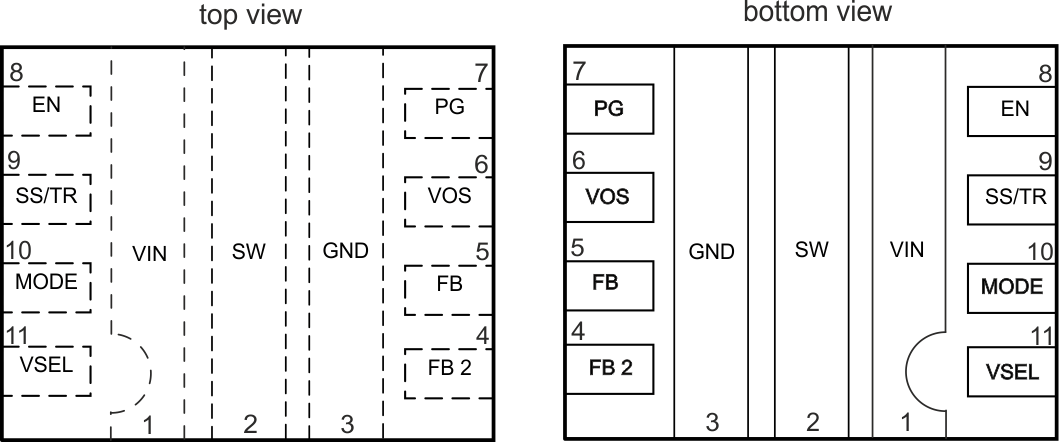SLVSBH3B June 2016 – April 2017 TPS62135
PRODUCTION DATA.
- 1 Features
- 2 Applications
- 3 Description
- 4 Revision History
- 5 Device Comparison Table
- 6 Pin Configuration and Functions
- 7 Specifications
- 8 Parameter Measurement Information
-
9 Detailed Description
- 9.1 Overview
- 9.2 Functional Block Diagram
- 9.3 Feature Description
- 9.4
Device Functional Modes
- 9.4.1 Pulse Width Modulation (PWM) Operation
- 9.4.2 Power Save Mode Operation (PWM/PFM)
- 9.4.3 100% Duty-Cycle Operation
- 9.4.4 HICCUP Current Limit And Short Circuit Protection (TPS62135 only)
- 9.4.5 Current Limit And Short Circuit Protection (TPS621351 only)
- 9.4.6 Soft-Start / Tracking (SS/TR)
- 9.4.7 Output Discharge Function (TPS62135 only)
- 9.4.8 Starting into a Pre-Biased Load (TPS621351 only)
- 10Application and Implementation
- 11Power Supply Recommendations
- 12Layout
- 13Device and Documentation Support
- 14Mechanical, Packaging, and Orderable Information
Package Options
Mechanical Data (Package|Pins)
- RGX|11
Thermal pad, mechanical data (Package|Pins)
Orderable Information
6 Pin Configuration and Functions
RGX Package
11-Pin VQFN

Pin Functions
| PIN | I/O | DESCRIPTION | |
|---|---|---|---|
| NAME | NUMBER | ||
| EN | 8 | I | This is the enable pin of the device. Connect to logic low to disable the device. Pull high to enable the device. Do not leave this pin unconnected. |
| FB | 5 | I | Voltage feedback input, connect resistive output voltage divider to this pin. |
| FB2 | 4 | O | Open drain of an internal switch to GND. Allows to turn on a resistor in parallel to the feedback resistor R2 and increase the output voltage with VSEL = high. |
| GND | 3 | Ground pin. | |
| MODE | 10 | I | The device runs in PFM/PWM mode when this pin is pulled low. When the pin is pulled high, the device runs in forced PWM mode. Do not leave this pin unconnected. |
| PG | 7 | O | Open drain power good output. |
| SS/TR | 9 | I | Soft-Start / Tracking pin. An external capacitor connected from this pin to GND defines the rise time for the internal reference voltage. The pin can also be used as an input for tracking and sequencing - see Detailed Description section in this document. |
| SW | 2 | This is the switch pin of the converter and is connected to the internal Power MOSFETs. | |
| VIN | 1 | Power supply input. Make sure the input capacitor is connected as close as possible between pin VIN and GND. | |
| VOS | 6 | I | Output voltage sense pin. Connect directly to the positive pin of the output capacitor. |
| VSEL | 11 | I | Voltage scaling control input. Turns on an internal switch from FB2 to GND when this pin is set high. |